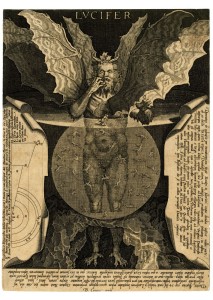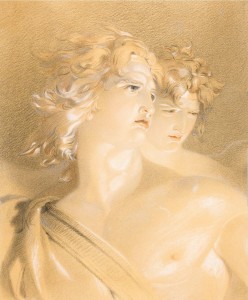Traditionally, just as Lucifer lost his illustrious name, so too had he lost his resplendent beauty, the refulgent angelic prince’s magnificent face and form marred as he was cast out from Heaven. The greatest of these deformed Devils was Dante’s Lucifer, who in the Inferno of The Divine Comedy (1308–1321) lies in the ninth and lowest circle of Hell, reserved for the treacherous. Dante’s Devil, frozen below the waist in unbreakable ice, is a grotesque sight: gigantic, hairy, and three-faced, each monstrous mouth chomping down on history’s great traitors, Judas, Brutus, and Cassius (XXXIV.28–67). Dante’s use of the name Lucifer is an ironic mockery of the perfidious angelic prince, who “was once as handsome as he now / is ugly,” imprisoned in the icy depths of Hell because he “raised his brows / against his Maker” (XXXIV.34–36). Yet if Dante’s Lucifer is as repulsive as he once was beautiful, Milton’s Satan is as magnificent as Dante’s Lucifer was monstrous, which is to say, the Satan of Milton’s Paradise Lost (1667) is more Luciferian than the Lucifer of Dante’s Inferno, so much so that while Dante’s Devil is Lucifer in name only, Milton’s Satan is Lucifer in all but name.

The extent of the Miltonic Satan’s glittering majesty is perhaps best demonstrated when he is contrasted with his closest literary cousins. In her study of The War in Heaven: Paradise Lost and the Tradition of Satan’s Rebellion, Stella Purce Revard posits that Milton’s epic hero Satan is an installment in a long line of Renaissance Lucifers.1 While there are certainly striking similarities, Milton’s Renaissance predecessors were unquestionably far more unforgiving when visualizing the Devil’s hellish fall, however generous they might have been when depicting his heavenly revolt. The medieval tradition of defacing the fallen angel is upheld by Torquato Tasso’s Gerusalemme liberate (Jerusalem Delivered, 1581), Giambattista Marini’s La Strage degli Innocenti (1610), Giambattista Andreini’s L’Adamo (1613), Joseph Beaumont’s Psyche, or Love’s Majesty (1648), and Joost van den Vondel’s Lucifer (1654).2
Vondel’s transformation of his Lucifer into a grotesque hodgepodge of several beasts as he falls from Heaven is only exceeded by Erasmo di Valvasone, whose L’Angeleida (1590) uniquely imagines a monstrous prelapsarian Lucifer, who appears in the War in Heaven as a seven-headed, hundred-handed, hundred-winged monstrosity. Milton’s Satan is no such thing, appearing on the heavenly battlefield in boundless majesty:
High in the midst exalted as a God
Th’ Apostate in his Sun-bright Chariot sat
Idol of Majesty Divine, enclos’d
With Flaming Cherubim, and golden Shields;
Then lighted from his gorgeous Throne.…
Satan with vast and haughty strides advanc’d,
Came tow’ring, arm’d in Adamant and Gold… (VI.99–110)

The most radical aspect of Milton’s vision, however, is that his “Prince of Darkness” (X.383) is not as darkened as he might have been. In Paradise Lost, the fallen archangel Satan remains in possession of much of his “Original brightness” (I.592), as do the fallen “Satanic Host” (VI.392), likened to a lightning-scorched but nonetheless stately forest (I.612–15). The fallen rebel angels, despite their diminished glory, bear “Godlike shapes and forms / Excelling human, Princely Dignities” (I.358–59), and no one is as princely and godlike as Satan himself:
…he above the rest
In shape and gesture proudly eminent
Stood like a Tow’r; his form had yet not lost
All her Original brightness, nor appear’d
Less than Arch-Angel ruin’d, and th’ excess
Of Glory obscur’d… (I.589–94)
Milton’s Satan was in Heaven “Sun-bright” (VI.100), and in Hell he is still likened to the Sun, but as obscured by a misty horizon or eclipsed by the Moon (I.592–99). Milton’s dimmed Devil, in short, is the fallen Lucifer, “Dark’n’d so, yet shone / Above them all th’ Arch-Angel…” (I.599–600).3 In this, Milton initiated the fallen Dark Prince’s re-ascension to Lucifer, the title he was to regain in the Romantic Era.
Notes
1. Stella Purce Revard, The War in Heaven: Paradise Lost and the Tradition of Satan’s Rebellion (Ithaca, NY and London: Cornell University Press, 1980), p. 198: “Satan, proud but magnificent, unyieldingly resolute in battle, emerges in the Renaissance poems wearing the full splendor of epic trappings. To these poems we owe in large measure the hero Satan as he is developed in Paradise Lost. Renaissance poets drew on two traditions to depict Satan or Lucifer: the hexaemeral and the epic. Hexaemera described Lucifer as a prince, glorious and unsurpassed, whose ambition caused him to strive above his sphere; epics described their heroes as superhuman in battle and accorded them, whatever their arrogance or mistakes in judgment, ‘grace’ to offend, even as they are called to account for their offenses. The Lucifer of the Renaissance thus combines Isaiah’s Lucifer with Homer’s Agamemnon, Virgil’s Turnus, and Tasso’s Rinaldo. Milton’s Satan, in turn, follows the Renaissance Lucifer and is both the prince depicted in hexaemera and the classical battle hero.”↩
2. See Watson Kirkconnell, The Celestial Cycle: The Theme of Paradise Lost in World Literature with Translations of the Major Analogues (Toronto: University of Toronto Press, 1952), pp. 59–61 (Tasso), 221 (Marini), 236 (Andreini), 350–51 (Beaumont), 414–15 (Vondel).↩
3. Milton reserved true hellish monstrousness for Sin and Death (II.648–73, 781–802), as well as the native denizens of Hell, “worse / Than Fables yet have feign’d, or fear conceiv’d, / Gorgons and Hydras, and Chimeras dire” (II.626–28). Of course, Milton does in the end bring his stately Satan low when he returns triumphantly to Hell: Satan is transformed into “A monstrous Serpent on his Belly prone” (X.514) at the conclusion of his exultant speech, Satan’s supporters suffering the same ignominy, “all transform’d / Alike, to Serpents all as accessories / To his bold Riot…” (X.519–21). Satan’s punishment seems reminiscent of Dante’s Inferno insofar as his punishment in Hell correlates to his crime on Earth, Satan “punisht in the shape he sinn’d, / According to his doom” (X.516–17), but in truth it is less harsh than Milton’s Renaissance predecessors, let alone Dante. Milton’s Satan and his coconspirators “thir lost shape, permitted, they resum’d,” their temporary transformation merely an “annual humbling certain number’d days, / To dash thir pride, and joy for Man seduc’t” (X.574, 576–77).↩